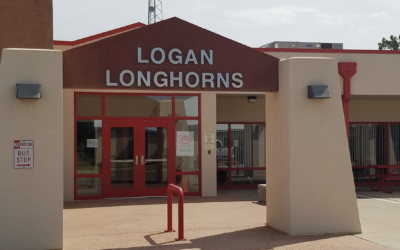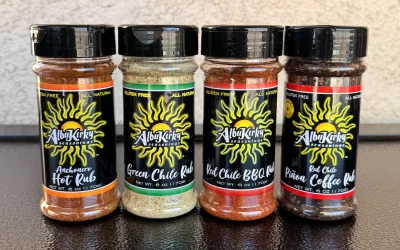About the Episode:
When you think of New Mexico, scuba diving and the Titanic might not be what first comes to mind. But this episode featuring a brave trail-blazing New Mexican will make you think again! Valerie Moor is an inspiration and her story is truly fascinating. Give this podcast a listen to find out why.
Links
Kaizen Scuba
Women Divers Hall of Fame
I Love New Mexico blog page
Bunny’s website
I Love New Mexico Instagram
I Love New Mexico Facebook
Original Music by: Kene Terry

Featuring:
Valerie Moore
A diving instructor, Valerie has combined writing, production and expedition logistics to pioneer new underwater horizons. The first Western woman journalist invited onboard the Russian R/V Keldysh, she is one of the world’s deepest diving women in the Mir submersibles. She has worked many film, salvage, and scientific expeditions, including Jim Cameron’s deep dive unit for the film Titanic. Valerie served as director of marine operations for RMS Titanic Expedition 2000. She’s a member of the Explorers Club and the Deep Submersible Pilots Association. (And now she is also a New Mexican!)
Episode Transcript
Bunny: (00:00)
Hi there. I’m Bunny Terry, and you’re listening to the I Love New Mexico podcast. Whether you’re a native new Mexican, who’s lived here for your entire life, or you’re just considering a visit, this episode is for you. Join us as we share a lot of New Mexico stories, talk about all things New Mexico, and include topics like what’s magical here, where you ought to visit, what’s happening, and the things you absolutely cannot miss in the land of Enchantment. We’re excited that you’re here, and we can’t wait to show you what an amazing place New Mexico is, because let’s face it, I love New Mexico Today on the I Love New Mexico podcast. We have a guest who is a good friend of mine and who, until we sat down and had a cup of coffee recently, I didn’t know Valerie’s full story, and I gotta tell you, spoiler alert, um, she is friends with James Cameron and has a very technical and personal relationship to filming of the Titanic. So stick around for the full story. But first of all, Valerie, thank you so much for agreeing to be on the podcast.
Valerie : (01:24)
Well, thank you so much for inviting me. What a pleasure. Thank you.
Bunny : (01:28)
Well, it’s I’m so fascinated by your story. You and I have been acquainted, um, in the, in both the real estate world and in the cancer treatment world. Um, you know, we’ve, we have several different connections, but when we sat down a few months ago just to visit, and you started telling me the story about how you decided, and, and if I have any details wrong, I know you’re going to correct them, but, but how you decided at one point to take on a new skill and a new hobby despite, um, perhaps some reservations and it changed your life. Um, I’m gonna wanna know that story, but first I wanna know Valerie, how did you end up in New Mexico? I’m curious about that, and I know our listeners are gonna be as well.
Valerie : (02:21)
So, I wound up in New Mexico. Um, there was a major life change, uh, for me in 2008. It was a, a separation, and I wanted to start over in a place that was somewhat familiar, but not, um, but still had new exciting horizons. And, um, I had visited here with family, extended family friends, and loved it, and had a friend here. And I called her and I said, Hey, I’m thinking of moving to Santa Fe. And she said, come on, you can stay with me until you figure out what you wanna do. And as they say, the rest is history, and I’m still here. And I think Santa Fe is one of the most amazing places I have ever visited and, and spent time.
Bunny : (03:15)
Well, I mean, it sounds, from what I know about you, you’re, um, would you have seen yourself I don’t know, 25 years ago as somebody who just took risks like that? Tell me, tell me about you.
Valerie : (03:33)
No, I mean, I was the most conservative, brought up, very conservative, um, never thought about taking risks. And then all of a sudden, you know, life presents these, shall we say, opportunities, and you can either say, Hey, I’m gonna go with it, or, or not. And some of the, the things that I said yes to had turned out in ways that I had no possible way of imagining where they would lead. And I’m grateful, uh, to have done that.
Bunny : (04:06)
Well, your story, Valerie, always makes me think of, um, that there, you know, there are all these quotes floating around about how, um, your greatest regret will not be the things you’ve done, but the things that you didn’t do. And I think that you’re a living example of what life can give you when you decide to say yes. I’m, so can you tell our listeners a little bit of the story that you told me when we got together about how you got involved in, um, diving?
Valerie : (04:41)
Well, yes, and it’s quite, I mean I’m still amazed at, at how things turned out. I got involved in diving, okay. I grew up in New York, um, was not very fond of the water, was actually rather afraid of it. And, and then life changed. And I, uh, was living in Memphis, Tennessee. And, uh, at that time, my husband decided to take, uh, diving lessons. And then all of the men folk in the family decided to dive. And my mother-in-law said, well, you know, if you don’t learn, you are going to be on the boat being what they call a bubble watcher, just somebody who sits on the boat and watches other people dive. So, with great trepidation, I learned to dive and wasn’t totally fond of it, but I did get my certification and was very proud of myself for that accomplishment. And that at a certain time, she decided to send everybody in the family except me on a dive trip. And I said, Hey, what about me? You’re the one who encouraged me to dive, and here I am, I’ve got my certification, and you’re saying that I’m not going. And she said, well, you’re not good enough. You’ll only mail them back
Bunny : (09:42)
Well, or, here’s one of my favorites is that luck is really just being prepared when the right opportunity prepared presents itself. Right.
Valerie : (09:51)
Oh, Bunny, you’re so right. You’re so right. So, um, wrote an article, um, got the cover of, well, hang,
Bunny : (10:00)
Hang on, hang on, hang on. I wanna hear more details about the diving for the, for the Spanish galion. What, I mean, what was that trip like?
Valerie : (10:11)
Well, it was quite amazing, of course, you know, Spanish Gallion, uh, all and it was called the, the Marvia and the Mavi went down in the 16 hundreds in The Bahamas. And of course, ships were wooden. And the only things that have survived, you know, to this day would be anything metal, because the wood has all, you know, rotted away. So there’s nothing left of that. So when this particular ship hit the reef and broke apart in the hundreds of years, ensuing the, um, whatever was on board has been scattered by, uh, waves and currents and covered with sand. And so that, that’s kind of the, there’s really no wreck to be found, per se, like there are with modern ship shipwrecks that were made of, of, uh, steel. But we, we went out to The Bahamas and they had identified the area where the wreck had gone down, and it was, it was fairly shallow, which was great because one can dive a lot longer in shallow depths. And I spent, I’m not sure how long with them, and salvaging, and it was just an amazing process because some days we would find silver bars, we would find, you know, gold, the gold balloons and pieces of aid and jewelry and raw emeralds, which look like broken green glass, but yet they’re actually emeralds that was on board this ship. Wow. So it, it was a, a great experience, and the article was well received, and there were a couple of things that this gentleman told me about writing. And he said, when if I tell you something and then I tell you it is off the record, it’s off the record. And so he would tell me these incredible stories, and he’d say, but you can’t print that. I went, okay,
Bunny : (14:37)
Let me, ask you this, Valerie, what year was this?
Valerie : (14:42)
Oh my gosh, this was like around 19 90, 19 91, somewhere
Bunny : (14:46)
In, okay, so you’re with hurricanes and lawsuits
Valerie : (14:51)
And, and so we actually could not salvage, but on board this particular ship were some very interesting people who would have added a great amount of knowledge had we been able to salvage the wreck. They were historians and photographers and people who knew the location of every bolt in on, on the Titanic. But since we couldn’t salvage, and we were, you know, hoping we would make it home because the, the weather was so treacherous, there were a couple of people on board who I, you know, we befriended each other. And one gentleman who was a National Geographic photographer, he has now passed away. His name was Ralph White, was on the original expedition that, that located the Titanic. And he said, you know, I have these friends who have this Russian research vessel, and no one has ever written about their deep submersible technology. Would you be interested in meeting with them and writing a story? And I said, yes. And of course, you know, I was thinking, oh, this is great. Nothing will ever happen. Well, about two weeks after we got home, I get a call from Moscow, from the, this gentleman who is head of the Russian ship, uh, and he is inviting me to come on board the ship and write about Russian deep submersible technology.
Bunny : (16:22)
And, and Valerie, when you talk about deep, first of all, how deep is the Titanic? How
Valerie : (16:30)
It’s, it’s about 12,500 feet.
Bunny : (16:33)
Holy mackerel,
Valerie : (16:46)
The, the vessels, uh, are rated for different depths. There are vessels now that have recently been, um, privately built by people like James Cameron and, and other investors who love the deep ocean, which can go down to the Marianna Trench, which is, uh, the deepest part of the ocean. So at the time, uh, the, the Russian submersibles were the only ones in tandem that existed. Uh, other countries had one submersible, but with two deep diving submersibles, there’s definitely a safety factor. So I, I went on board the ship and wrote this article. It was well received by the Russians that got published, and they kept inviting me back to, you know, like, go with us. We’re going to Africa, we’re looking for a submarine that went down in, in World War ii or come with us. We’re, we’re going to this, uh, scientific conference and whatever. So I became sort of the adopted western daughter of this ship, which was called the Academic Mystic La Kish. And the, the friendship grew. And then along comes this gentleman named James Cameron, who decides to do a film about the Titanic. And what he wanted to do was film the actual wreckage in a way that had not been filmed before, which was to film it with a camera mounted outside a submersible rather than shot through like a foot of plexiglass, which is what would happen on, on a submersible. So when, when the topic came up of, and of, of who do the Russians, cuz they were newly out of the Soviet system at that time, uh, trust, who do the Russians trust and who can work with Hollywood? A couple of names came up, uh, my friend Ralph, uh, from The Geographic and my name, and we became the coordinators of the Deep dive unit when Jim photographed the wreck of the Titanic for the film, which, uh, has obviously become, become a classic. So tell me, sort
Bunny : (19:26)
Valerie : (19:39)
Well, it, it was a com funny, it was a combination of things. It was like, oh my gosh, I can’t believe I’m here. You know, I mean, um, from the, the person who had a hard time clearing her mask in the swimming pool to get her certification, uh, to be a dive instructor and teach diving and travel, you know, leading groups to finding myself as part of this cutting edge technology on board a Russian research ship, which it had like 17 scientific labs on it. And up until that time, the ship had never been used for anything except science. So in a way, the Russians were like, what, what, what is this? You know, we’re letting our ship be, um, contracted to do a film. And that was kind of a, a mindblowing thing for them, that it wasn’t pure science. And so we were out over the wreck of the Titanic for weeks, um, photographing, you know, the, the Titanic, um, to get there from the surface, to actually go down the, the 12,500 feet takes about two and a half hours time to descend. And then depending on how much battery life you have for photography, um, you stay down there and then it’s another two and a half hours back up to the surface. So my role on this particular, uh, deep dive unit was, was basically operations. It was scheduling. I was the liaison with Fox Studios who kept wondering, what are you doing out there in the ocean and why is it taking so long?
Bunny : (22:21)
I’m curious about, um, and we, we, um, we didn’t talk about this when we talked before, but, um, you, once you saw the film, did you think, oh, he he got it exactly right? Or were you like, that’s a little hokey. I’m, I’m just curious, um, what that felt like to you when you saw the finished product?
Valerie : (22:42)
That’s a great question. Bunny, the first time I watched the film, I watched it and I was thinking of, oh, you know, the, you know when, like when Rose is running down the corridor and the water is, you know, climbing up, I mean, I just knew some, like how some of those things were done. Like there were divers on rebreather, so there would be no bubbles, just like lying there in case she fell to help her up. And I thought, wow, all the technical things that went on behind the scenes to actually accomplish that particular shot, or, you know, in that place in the film. And, and so I watched it going, okay, and this is how they did that, and this is how they did that. And I kind of had this, you know, very detached feeling, watching it.
Valerie : (23:34)
The next time I watched the film, I kind of let it all go and just watched it as, uh, an emotional experience. And quite honestly, it, it, it blew me away. It was, um, I, I mean the, I mean, of course, obviously the real story I think the reason why Titanic resonates so much with people today is that we, we knew the names of the people on board. Um, we could have some sort of recognition of, of who they were. It wasn’t just nameless people. But after, after the film, I, I actually went back to the Titanic a couple of times, once with the history channel to do a documentary and another time to actually, um, help salvage the wreck with the group that had the rights to do that. And I worked as an expedition coordinator getting everything together to be able to go out in the ocean and mount an expedition like that. So it, and, uh, I have to say that there, on, on every expedition, there was a lot of reverence of where we were and, and what we were doing, as well as being very mindful that here we are over the wreck and, you know, we don’t wanna become part of it. So let’s look out for the icebergs.
Bunny : (25:04)
Valerie : (25:16)
Oh my gosh. The temperature of the water, uh, in the North Atlantic is, uh, you know, like at the time that the Titanic went down was probably about right above freezing. Wow. So like 34 degrees there, there have been Titanic, um, exhibitions that have been mounted, that have presented the artifacts, uh, in some very amazing ways to make the viewer really feel part of it. And, and one of the things that one of the exhibits did that I think was incredible, they had a wall of, of ice, so to speak, that was at just around, you know, it was sort of melting and slushy, but they said, put your hand on this and the temperature is like 34, 35 degrees and see how long you can leave your hand there. So most of the people who perished, um, was, you know, from exposure because the, you know, the human body can only, you know, be in, in cold water for so long like that. Wow. So, I mean, certainly a, a huge tragedy and, and I hope, um, um, everyone has, you know, learned lessons from, you know, the, the arrogance of full speed ahead and all that kind of thing that it, it doesn’t necessarily benefit. So, but yeah. Incredible adventures. And I, once again, I look back on it and all the people I met and all the folks that I still keep up with and think, you know, how lucky. So gratitude once again, Bunny gratitude for having these life experiences.
Bunny : (27:09)
Well, I’m really curious. I sent you this question ahead of time because, um, I, you know, we are talking, we have a lot of guests who are obviously, or a lot of listeners who are not from New Mexico, and I’m sure they’re thinking, well, what do you do now that you live in this landlocked state
Valerie : (27:34)
I have not been diving in New Mexico. When people ask me that question, it’s like, why are you in New Mexico? Well, there are places to dive in New Mexico, but once again, New Mexico has wonderful airports where we can, you know, get on a plane and go to whatever fabulous dive site, you know, location, um, and travel, you know, by ourselves or with a group and, and adventure that way. I mean, New Mexico except for an ocean probably, you know, Santa Fe has everything, you know, I mean, it’s, it’s such an incredible city, um, as you know. And I mean, everyone who lives here I think loves and appreciates it because it, it really has everything.
Bunny : (28:23)
Well, and I do notion
Valerie : (28:33)
Right. And, and you know, when, when a diver wants to get certified, um, after the pool training and the, um, book training classroom part is over, um, everyone goes to what’s called open water, which is a lake or an ocean, and of course it, it’s just a place where you can’t grab a hold of the side of the pool. And so, um, you know, blue hole, some of the other lakes, um, are perfect places to get certified as, as a way to, you know, in pre in preparation to go on to greater adventures.
Bunny : (29:09)
Well, tell me, because I really, I mean, I grew up in New Mexico I like still water, you know, I, like, I grew up at a lake, but if you, if we were talking, if we have a listener who finds themself a little fearful of the ocean mm-hmm.
Valerie : (29:42)
Well, it’s, it’s, it’s a matter of, of getting, um, accustomed to, um, the ocean or, or whatever environment you’re in. And, and in the case of say, learning to dive, when people learn to dive, it’s done in a pool. So the conditions are extraordinarily controlled. You’re not by yourself, you’re with instructors who will not let anything happen to you. And you learn to get comfortable with your equipment. You learn to get comfortable with the, the, the sound of what it sounds like when you’re breathing through a regulator, which sounds a bit like Darth of Vader, which can be a bit off-put. But, um, and then when you’re ready, you know, then when you’re ready, you do all these other exercises, and then finally you go to the open water. And there are places that in the ocean that are so perfect for diving and snorkeling that are more, um, protected, that are not just way out there in the middle of, of nowhere. And, and there’s always people around, um, who know the area if you’re doing it pro appropriately. Um, there are dive guides. They’re your instructors and you travel with them. So it it, there, there’s a comfort factor in, in it’s experience, and you just get comfortable with your gear.
Bunny : (31:06)
So what’s the deepest, you’ve been,
Valerie : (31:10)
The deepest that I have been, we were off the coast of, um, Senegal in Africa. We were looking for a World War II submarine that went down, um, and we were down to about, I guess 18,000 plus feet. Wow. Um, in, in the, of course this Russian submersible, and it’s a controlled environment, meaning, you know, you, you’re surrounded by titanium and foot thick plexiglass windows. And, um, in so far, knock wood, the, uh, history of diving submersibles has been a very safe one. And you just go, okay, you know, I have faith in the person who built this, but it is, it is kind of an amazing experience to know that when you climb into a submersible and they close the hatch, that it could be anywhere from, you know, 1216 hours. The, the, the, that deep dive that I did off the coast of Africa, we were in the submersible for about, I guess 16 hours. Wow.
Bunny : (32:22)
Valerie : (32:28)
Well, you know, I’ll tell you one story money that, that sort of puts so many things in, in perspective is that, um, so what happens when you, you descend in the ocean in a submersible, is that you start off at ambient temperature, whatever it is, on the deck of the ship. And then that crane lifts the submersible into the water. And as you start descending it, the, the interior of the sub does what they call cult soaks. It, it like, starts raining almost because of the condensation. And you slip into like a schema suit and hats and gloves, cuz it gets to be like freezing inside that capsule cuz there’s no heat in there. And so when we were doing this dive looking for this submarine, um, you kind of keep all the, the lights off except for a dim light maybe inside the, the capsule, but you keep the lights on the outside off because you wanna conserve battery power. And I couldn’t stand it. And I said to the, the, these Russian pilots, and I said, so there’s three people in this little cockpit. And I said, can you turn on the lights? I wanna see what’s out there. And they said, okay, we turn it on and just to see what’s out there. So they turn the lights on and there were these incredible creatures, which lately, now if, if you look on say a National Geographics website, you’ll see these creatures, these fish that are only now being seen because only now can we get down there to see them. But at that point there, there’s something swam by the portal. And I said, what is that? And the Russians looked at me and they said, how do we know no one has ever been here before?
Bunny : (34:50)
Valerie. It is, it’s so, this is such a cool story and I feel so privileged to know, to have you as my friend, but, um, I, I hope that you are, I hope there’s a book occurring. I hope that you’re writing this all down and, and telling us the stories.
Valerie : (35:08)
Thank, thank you Bunny. You’re so encouraging and you have encouraged me and, and, and I, and I am because you know, sometimes when something is your experience, you go, oh, well, you know, nobody is gonna really be interested in all this. But you have encouraged me to do that. So I thank you profusely for, um, inspiring me.
Bunny : (35:35)
Well, I mean, we say it all the time that stories save us, but I think the story of you, um, doing something that was outta your comfort zone and then taking that to a new level is so I’m just so proud to know you. So, um, so this podcast is devoted to people in New Mexico who do amazing things, and you’re one of those people. So I’m, I’m, I’m so excited that you agreed to come and talk to us about this. I wanna know when the
Valerie : (36:14)
Funny. Thank you so much, um, for your encouragement, for being there, for sharing your incredible story with everyone. You are such an inspiration. And you know, there are times when, you know, when, when life gets to, to all of us. And I think look at Bunny, look where she is. She’s just amazing and she’s thriving and her story is one that just leaves, you know, everyone breathless of, of, of, of, and you owe it all to gratitude. So I am very grateful to you Bunny, for welcome your inspiration.
Bunny : (36:53)
Thank you for that. So are you, and, and James Cameron, are you, you and Jim gonna collaborate on another adventure soon?
Valerie : (37:02)
Well, uh, Jim is very much into avatar as, as we all know, that’s true. There’s lots of, there’s lots of, there’s lots of blue creatures, um, in the future. And, um, he is, I mean, it’s, it’s amazing and, you know, his attention to detail, whether it was on Titanic or with Avatar, um, and the technological advances that he has come up with to be able to do Titanic in its time and now, uh, produce the avatar films is incredible. I mean, the, the man is, is really a genius. And, um, he just keeps going. He loves water. I mean, and part of, you know, you can see a theme going. He has an incredible love of the ocean.
Bunny : (37:56)
Well, um, as do you I guess. And so, um, I’m anxious to see what you do next, Valerie, let’s talk again.
Valerie : (38:04)
Well, let’s do that. I’m anxious to see what I do next too. Thank you.
About the Podcast
Recent Episodes
I Love New Mexico Teachers: Bunny Terry
About the Episode: Summer is coming to an end and a new school year is...
I Love New Mexico Food: Kirk Muncrief of AlbuKirky Seasonings
About the Episode: In New Mexico you know we love food AND we love spicy...
100th Episode Recap: Bunny & Johanna
About the Episode: The I Love New Mexico podcast has made it to 100...










 Bunny Terry is a native New Mexican who grew up on a farm in northeastern New Mexico. Her first writing job was typing stories on index cards on her family’s Underwood, stories that were uncannily like the ones she read over and over in O Ye’ Jigs and Julips, her favorite childhood book. No one thought to save those index cards for posterity, although there is the theory sarcastically circulated by her siblings that they will certainly be worth millions someday.
Bunny Terry is a native New Mexican who grew up on a farm in northeastern New Mexico. Her first writing job was typing stories on index cards on her family’s Underwood, stories that were uncannily like the ones she read over and over in O Ye’ Jigs and Julips, her favorite childhood book. No one thought to save those index cards for posterity, although there is the theory sarcastically circulated by her siblings that they will certainly be worth millions someday. 